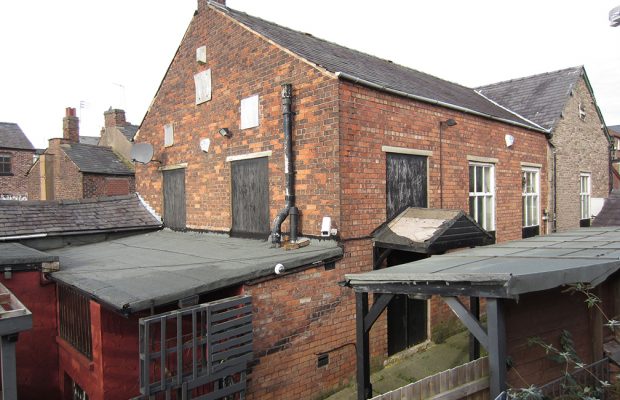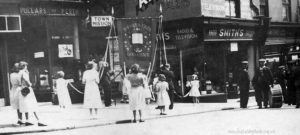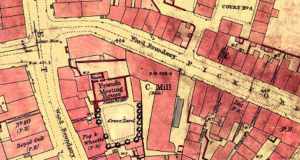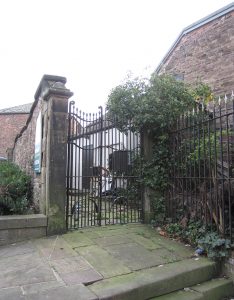- Home
- News
- What’s On
- Activities for Children
- Arts & Crafts
- Autos and Bikes
- Business events
- Car Boot & Auctions
- Charity events
- Churches & Religious
- Comedy
- Dance
- Days out & Local interest
- Education
- Exhibition
- Film
- Gardening & Horticulture
- Health
- Markets & Fairs
- Music
- Nature & Environment
- Spiritual
- Sport
- Talks and Discussions
- Theatre and Drama
- Business
- Local Information
- Jobs
- Deaths
- Charity events
- Contact Us
Lest we forget: Macclesfield’s War Memorials

Above and below: Mill Street Mission, for a number of years home to Preachers night club, as it is today. Images: Geoff Archer
As detailed in http://www.ilovemacc.com/2017/10/27/war-memorial-rediscovered-silk-museum/, an old brass plaque was recently rediscovered.
It carried the name ‘Macclesfield Mill Street Mission’ and below were the names of sixteen men and one woman.
Known from newspaper reports when first unveiled in July 1919 but long assumed to have been destroyed, this was a memorial to those of the Mission’s members who had died in the First World War; thankfully the Museum must have offered a safe place to store it after it had been removed from its original location.

Mill Street showing entrance to Macclesfield Town Mission in 1951. Smith’s Radio and TV shop is now a hairdressers. Image: Joseph Dowse. Click to enlarge.
The Mill Street Mission was opened in 1888. The City Mission movement began in Glasgow in the 1820s, its aim being to provide both spiritual and material support for the urban poor, and missions were subsequently opened across Britain, and elsewhere, particularly in America. In 1888 the secretary of the Manchester City Mission visited Macclesfield to explore the possibilities of opening a branch in the town. The Friends Meeting House off Mill Street, built for the Quakers in the eighteenth century, stood empty. This became the new Mission. The Mill Street Mission closed some years ago and it was presumably at this time that the memorial was passed to Macclesfield Museums for safe keeping.

Map showing position of Macclesfield Mission courtesy of macclesfieldreflects.org.uk. Click on image to enlarge.
The Mill Street Mission memorial is of particular interest in being the only memorial in the town to feature the name of a woman, Sarah Ann Wiggin. Sarah Wiggin (not Wiggins as her name is spelt on the plaque) was born in December 1887 in Brindley Ford, a small village south of Congleton. Sarah’s mother Lucy died when she was still a baby and she was brought up by her father, Joseph. By 1901 Sarah, aged 13, was working as a servant in Tunstall but ten years later she was a servant for Nathan and Harriett Storey at 54 West Bond Street, Macclesfield. Nathan and Harriett were both employed as preachers at the Mill Street Mission and no doubt Sarah was encouraged to attend.
When war broke out Sarah became a V.A.D. (Voluntary Aid Detachment) nurse, serving with the Royal Medical Corps. In 1918 she was working as a Sister at the Military Auxiliary Hospital in Moor Park in Preston and it was here, on 2 November, that she died of the Spanish flu. Sarah’s name was added to her mother’s gravestone in St James’s churchyard in Newchapel, near Brindley Ford, though whether she was buried there or in Preston is not known. Her father still lived in Brindley Ford and her name is included on the village war memorial there.
In many ways the men listed on the Mill Street Mission memorial plaque – William Belfield, Arthur Burgess, John Dennerley, John Findlow, Alfred Mellor, Matthew Oakes, George Pickering, Joseph Pomfret, Frederick Proffitt, Walter Slater, Arthur Sutton, Henry Tester, Joseph Tomkinson, Frederick Wardle, Joseph Wardle and James Widdows – present a typical cross-section of Macclesfield men who fought and died. The youngest was just nineteen when killed in action in 1918; the oldest was forty-five. Some were single, some married with young families. They fought in France and Belgium, at Gallipoli and in the Middle East. Most were buried in battlefield cemeteries; some died at home and are buried in Macclesfield; some have no known grave. All are named not only here but at Park Green, St Michael’s, the Town Hall and on a range of other memorials in the town.
Macclesfield has over forty First World War memorials of one sort or another. In addition to the remembrance of individuals, memorials were produced for churches, schools, Sunday schools, mills and clubs. And of course there were memorials dedicated to the whole community, most notably at Park Green. Over the years, when churches, mills or schools have closed, all too often the memorials they housed have simply been discarded. A number have literally been rescued from the skips into which they had been thrown. Others, thankfully, have been passed on for safe keeping and seven of these (plus three Second World War memorials) are currently displayed in Christ Church.
Other memorials are known to have been produced but have subsequently vanished. Some have undoubtedly been destroyed. However, as the rediscovery of the Mill Street Mission memorial suggests, it is possible that some of these memorials may yet turn up. It is also possible that unknown memorials wait to be discovered. Only two of Macclesfield’s many mills are known to have had memorials – both now unfortunately lost – but it seems highly likely that other mills would have commissioned memorials to their workers killed in the war.
If any reader knows of the existence of other memorials, the Macclesfield and District World War One Centenary Committee would be very pleased to hear from you. Any information can be sent to Rosie Rowley at www.macclesfieldreflects.org.uk, the excellent website she has created to provide information about Macclesfield men and women and the parts they played in World War One.
To find out more on the wide range of First World War memorials in and around Macclesfield see Geoff Archer’s book ‘Not Forgotten’, and for information on over 600 men named at Park Green, including all of the men named on the Mill Street Mission memorial, see Harry Carlisle’s book ‘More Than a Name’. Both books can be ordered via the Macclesfield Reflects website, or purchased from Macclesfield Visitor Information Centre, where a free memorial trail booklet produced by Geoff is also available.


You must be logged in to post a comment Login